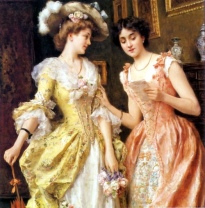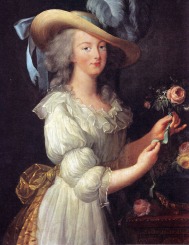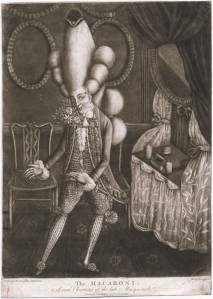What Country/countries Was Rococo Fashionable in?
A significant shift in culture occurred in France and elsewhere at the showtime of the 18th century, known as the Enlightenment, which valued reason over authority. In French republic, the sphere of influence for art, culture and way shifted from Versailles to Paris, where the educated bourgeoisie class gained influence and power in salons and cafés. The new fashions introduced therefore had a greater bear on on order, affecting not just royalty and aristocrats, but likewise middle and even lower classes. Ironically, the single well-nigh important figure to establish Rococo fashions was Louis Fifteen's mistress Madame Pompadour. She adored pastel colors and the light, happy fashion which came to be known as Rococo, and subsequently light stripe and floral patterns became popular. Towards the end of the period, Marie Antoinette became the leader of French fashion, as did her dressmaker Rose Bertin. Extreme extravagance was her trademark, which concluded up majorly fanning the flames of the French Revolution.


Style designers gained even more influence during this era, as people scrambled to be clothed in the latest styles. Style magazines emerged during this era, originally aimed at intelligent readers, but quickly capturing the attention of lower classes with their colorful illustrations and up-to-appointment way news. Even though the fashion industry was ruined temporarily in France during the Revolution, information technology flourished in other European countries, especially England.
 During this menstruum, a new silhouette for women was developing. Panniers, or wide hoops worn under the skirt that extended sideways, became a staple. Extremely broad panniers were worn to formal occasions, while smaller ones were worn in everyday settings. Waists were tightly constricted by corsets, provided contrasts to the wide skirts. Plunging necklines as well became common. Skirts commonly opened at the front, displaying an underskirt or petticoat. Pagoda sleeves arose well-nigh halfway through the 18th century, which were tight from shoulder to elbow and ended with flared lace and ribbons. In that location were a few primary types of dresses worn during this period. The Watteau gown had a loose back which became office of the total skirt and a tight bodice. The robe à la française a
During this menstruum, a new silhouette for women was developing. Panniers, or wide hoops worn under the skirt that extended sideways, became a staple. Extremely broad panniers were worn to formal occasions, while smaller ones were worn in everyday settings. Waists were tightly constricted by corsets, provided contrasts to the wide skirts. Plunging necklines as well became common. Skirts commonly opened at the front, displaying an underskirt or petticoat. Pagoda sleeves arose well-nigh halfway through the 18th century, which were tight from shoulder to elbow and ended with flared lace and ribbons. In that location were a few primary types of dresses worn during this period. The Watteau gown had a loose back which became office of the total skirt and a tight bodice. The robe à la française a lso had a tight bodice with a low-cutting square neckline, commonly with big ribbon bows downwards the forepart, broad panniers, and was lavishly trimmed with all way of lace, ribbon, and flowers. The robe à 50'anglais featured a snug bodice with a total skirt worn without panniers, usually cut a bit longer in the back to form a pocket-size train, and frequently some type of lace kerchief was worn around the neckline. These gowns were oft worn with short, wide-lapeled jackets modeled after men's redingotes. Marie Antoinette introduced the chemise à la reine (pictured right), a loose white gown with a colorful silk sash around the waist. This was considered shocking for women at first, as no corset was worn and the natural figure was apparent. However, women seized upon this style, using it as a symbol of their increased liberation.
lso had a tight bodice with a low-cutting square neckline, commonly with big ribbon bows downwards the forepart, broad panniers, and was lavishly trimmed with all way of lace, ribbon, and flowers. The robe à 50'anglais featured a snug bodice with a total skirt worn without panniers, usually cut a bit longer in the back to form a pocket-size train, and frequently some type of lace kerchief was worn around the neckline. These gowns were oft worn with short, wide-lapeled jackets modeled after men's redingotes. Marie Antoinette introduced the chemise à la reine (pictured right), a loose white gown with a colorful silk sash around the waist. This was considered shocking for women at first, as no corset was worn and the natural figure was apparent. However, women seized upon this style, using it as a symbol of their increased liberation.
Women's heels became much daintier with slimmer heels and pretty decorations. At the beginning of the catamenia, women wore their hair tight to the head, sometimes powdered or topped with lace kerchiefs, a stark contrast to their wide panniers. Nevertheless, hair progressively was worn higher and college until wigs were required. These towering tresses were elaborately curled and adorned with feathers, flowers, miniature sculptures and figures. Hair was powdered with wheat meal and flour, which caused outrage among lower classes as the price of staff of life became dangerously high.
 Men generally wore unlike variations of the habit à la française: a coat, waistcoat, and breeches. The waistcoat was the most decorative piece, usually lavishly embroidered or displaying patterned fabrics. Lace jabots were notwithstanding worn tied effectually the neck. Breeches usually stopped at the knee, with white stockings worn underneath and heeled shoes, which usually had large square buckles. Coats were worn closer to the body and were not as skirt-like every bit during the Baroque era. They were as well worn more than open to showcase the elaborate waistcoats. Tricorne hats became popular during this period, oftentimes edged with braid and busy with ostrich feathers. Wigs were unremarkably worn past men, preferably white. The cadogan fashion of men's hair developed and became popular during th
Men generally wore unlike variations of the habit à la française: a coat, waistcoat, and breeches. The waistcoat was the most decorative piece, usually lavishly embroidered or displaying patterned fabrics. Lace jabots were notwithstanding worn tied effectually the neck. Breeches usually stopped at the knee, with white stockings worn underneath and heeled shoes, which usually had large square buckles. Coats were worn closer to the body and were not as skirt-like every bit during the Baroque era. They were as well worn more than open to showcase the elaborate waistcoats. Tricorne hats became popular during this period, oftentimes edged with braid and busy with ostrich feathers. Wigs were unremarkably worn past men, preferably white. The cadogan fashion of men's hair developed and became popular during th e period, with horizontal rolls of pilus over the ears. French elites and aristocrats wore peculiarly lavish clothing and were often referred to as "Macaronis," every bit pictured in the caricature on the correct. The lower grade loathed their open prove of wealth when they themselves dressed in little more than rags.
e period, with horizontal rolls of pilus over the ears. French elites and aristocrats wore peculiarly lavish clothing and were often referred to as "Macaronis," every bit pictured in the caricature on the correct. The lower grade loathed their open prove of wealth when they themselves dressed in little more than rags.
Mode played a big role in the French Revolution. Revolutionaries characterized themselves by patriotically wearing the tricolor—red, white, and blueish—on rosettes, skirts, breeches, etc. Since virtually of the rebellion was achieved by the lower form, they called themselves sans-culottes, or "without breeches," every bit they wore talocrural joint-length trousers of the working class. This caused knee breeches to get extremely unpopular and even dangerous to clothing in France. Clothing became a matter of life or death; riots and murders could be caused simply considering someone was not wearing a tricolor rosette and people wearing extravagant gowns or suits were accused of being aristocrats.
The Rococo era was defined past seemingly contrasting aspects: extravagance and a quest for simplicity, low-cal colors and heavy materials, aristocrats and the bourgeoisie. This culmination produced a very diverse era in fashion like none ever before. Although this movement was largely ended with the French Revolution, its ideas and main aspects strongly affected time to come fashions for decades.

Read Full Post »
0 Response to "What Country/countries Was Rococo Fashionable in?"
Post a Comment